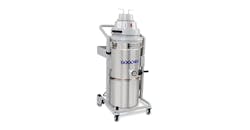10 Tips to Help Prevent Dangerous Dust Explosions
As history has proven, dust buildup can lead to hazardous, and even deadly explosions. While these recurring tragedies often serve as a solemn reminder, Goodway Technologies is reiterating to facility managers of the importance of proper cleaning and maintenance, and sharing best practices on being proactive to help prevent dust explosions.
According to a report from the U.S. Chemical Safety Board, there were 281 combustible dust incidents between 1980 and 2005, which resulted in 119 fatalities and 718 injuries. Since the release of that report in 2006, there have been an additional 105 incidents.
“Any facility that produces dust is at risk, which means dust explosions are a serious danger in many industries,” says Tim Kane, President of Goodway Technologies. “It’s critical that facility managers take the appropriate steps to educate employees and implement strategies that help prevent a potential disaster.”
Goodway, a global manufacturer of industrial maintenance and cleaning solutions, is offering the following tips to help prevent dangerous dust explosions.
- Know that most dust is combustible. According to the Occupational Safety and Health Administration (OSHA), any solid that can catch fire can become explosive when turned into dust. The National Fire Protection Association's Industrial Fire Hazards Handbook states, "Any industrial process that reduces a combustible material and some normally noncombustible materials to a finely divided state, presents a potential for a serious fire, or explosion. For example, aluminum, bronze and polypropylene dust are all combustible.”
- Provide access to all hidden areas of your plant. It is important that you are able to access every horizontal surface of your plant. This includes ductwork, beam and joist surfaces and the area above suspended ceilings.
- Regularly inspect for dust buildup. OSHA inspectors look for accumulations of 1/32 of an inch, about the thickness of a standard paper clip. If a layer of that thickness covers a surface area equal to 5% of the floor area (include dust on all surfaces beams, joists, ducts, etc. when determining the dust coverage area) an immediate cleaning is necessary. Besides keeping dust in check, regular cleaning rounds can reveal an increase in dust particle buildup, possibly alerting you to equipment maintenance needs.
- Clean at regular intervals. Maintain an ongoing cleaning schedule and include all horizontal surfaces. Work cycle dust should be removed concurrently with operations. Be mindful to minimize dust dispersion while cleaning.
- Move dust collectors outside. OSHA recommends that dust collectors with a volume greater than 8 cubic feet should be located outside of buildings, to limit the risk of further dust displacement.
- Ensure electrical wiring and equipment is approved for use in your dust hazard conditions. Review OSHA 29 CFR 1910.399 to determine your level of hazard. According to OSHA, "The use of proper electrical equipment in hazardous locations is crucial to eliminating a common ignition source.”
- Use only vacuum cleaners approved for dust collection in your hazard conditions. For example, vacuums approved for Class II conditions don’t produce sparks and are essential in hazardous dust environments.
- Control ignition sources. Display “No Smoking” signs throughout the facility. You can also help control static electricity by bonding and grounding equipment. Personal protective equipment can help prevent the ignition from static electricity while also serving as a protective barrier for employees.
- Perform regular preventative maintenance on equipment. A common cause of ignition is equipment that hasn’t been properly maintained. Check your user manual to see how often the manufacturer recommends conducting maintenance and get it scheduled.
- Train employees to recognize and prevent hazards. Before they even begin work, make sure to walk employees through the potential hazards and safe work practices related to their work. Provide employees with information on overall plant programs for dust control and ignition source control. Train again periodically. Make sure employees feel comfortable and have a process for reporting any unsafe practices.
Goodway offers a variety of wet and dry industrial vacuums that are certified for hazardous and flammable material pickup. For more information, visit www.goodway.com or call 1-800-333-7467.
About the Author
Goodway Technologies Corp.
Goodway Technologies is a global manufacturer and marketer of industrial maintenance and cleaning solutions for commercial HVAC, facility management, food and beverage, manufacturing, power generation, maritime and other industrial applications.
Incorporated in 1966, our innovative products have been used by facilities and plant maintenance personnel worldwide for the maintenance of HVAC systems, plant machinery, hazardous material cleanup and other industrial maintenance needs. We manufacture and ship from a 60,000 square foot plant in Stamford, CT, USA. Our products include tube cleaning systems, industrial vacuums, cooling tower maintenance systems, dry vapor sanitation solutions, descaling systems, coil cleaning products, hose & pipe cleaning systems and more.
